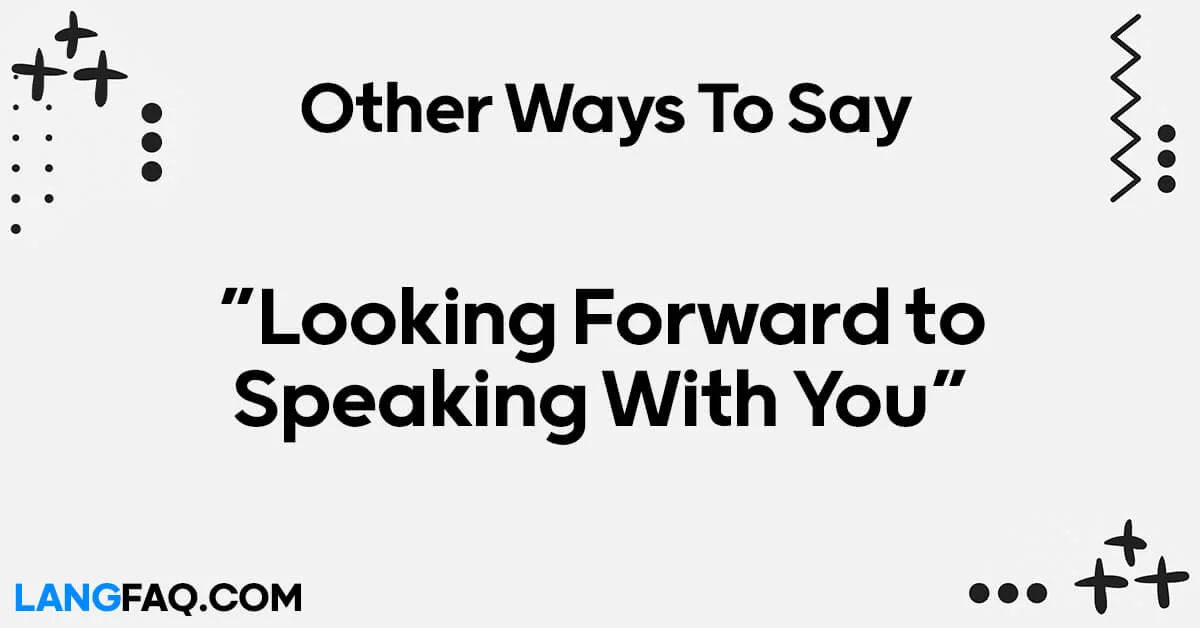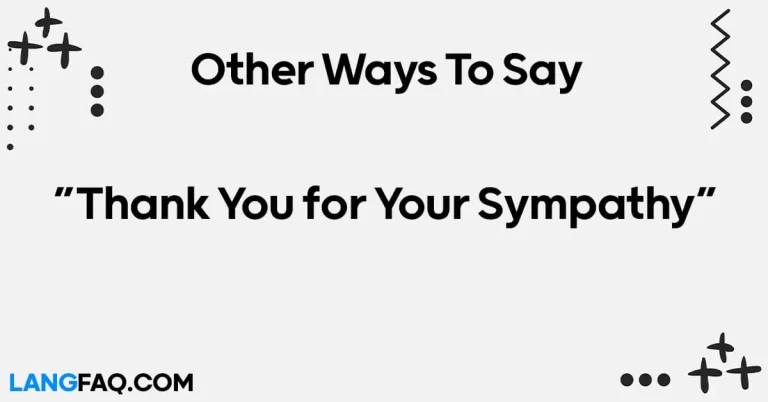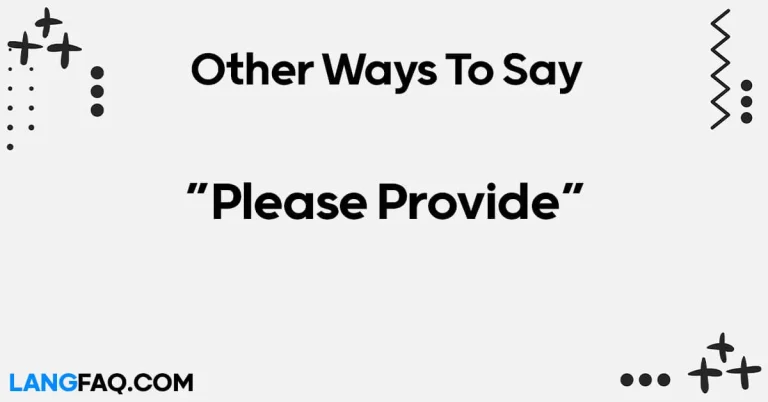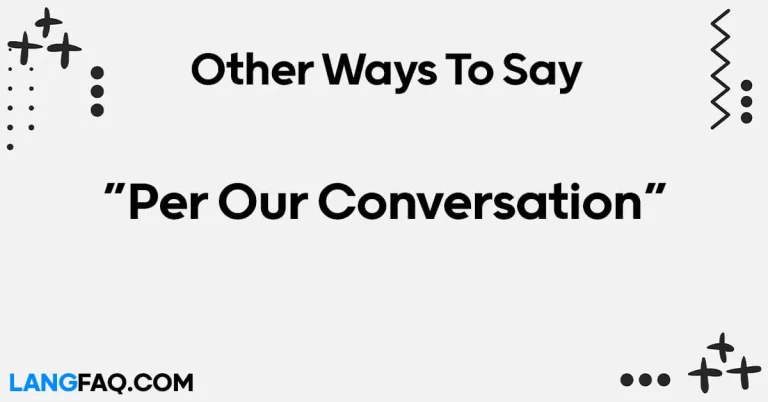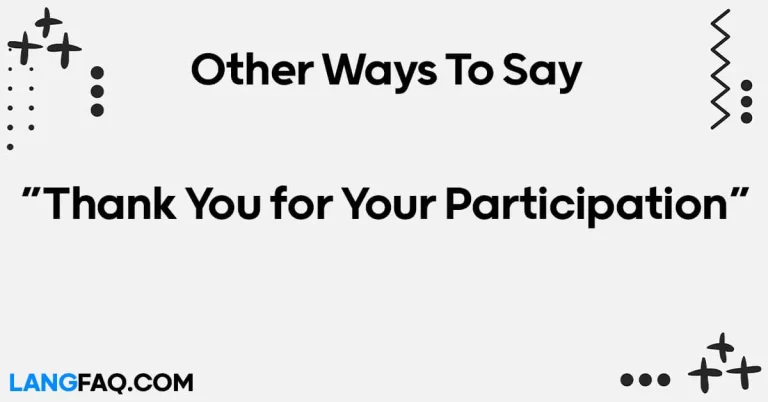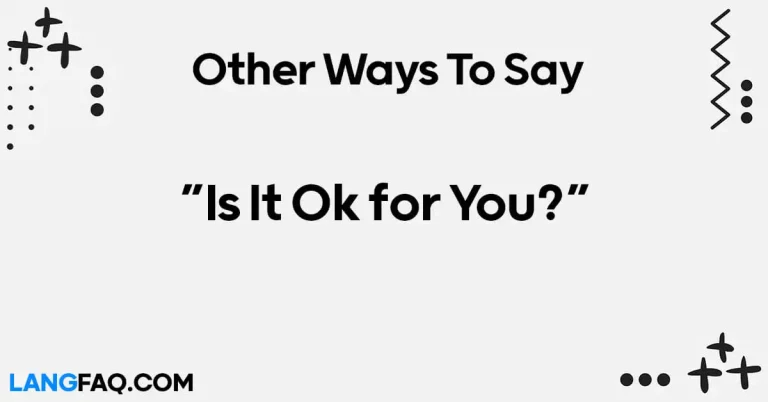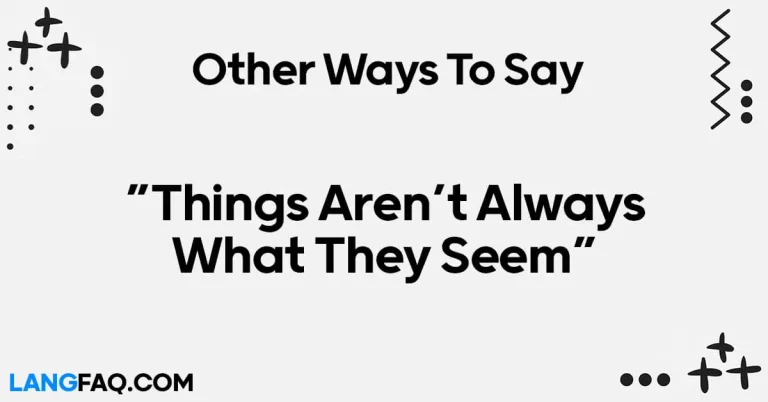In professional correspondence, expressing anticipation for future communication is essential for maintaining positive rapport. However, using the same phrase repeatedly can make your messages sound monotonous and uninspired. Fear not! In this comprehensive guide, we unveil 12 refreshing alternatives to “Looking Forward to Speaking With You” that will invigorate your communication style and leave a lasting impression on your recipients.
12 Other Ways to Say “Looking Forward to Speaking With You”
- Excited to connect with you soon!
- Can’t wait to chat with you!
- Eagerly anticipating our conversation.
- Anxiously looking forward to speaking with you.
- Thrilled for our upcoming discussion.
- Counting down the moments until we speak.
- Anticipating our dialogue with enthusiasm.
- Longing for our conversation.
- Enthusiastically awaiting our exchange.
- Looking ahead to our chat.
- Anticipating our interaction with excitement.
- Ready and eager to engage in conversation with you.
| Expression | Meaning | Example |
|---|---|---|
| Excited to connect with you soon! | Expresses enthusiasm for future communication. | “I’m excited to connect with you soon to discuss our project.” |
| Can’t wait to chat with you! | Conveys eagerness and anticipation. | “Can’t wait to chat with you about your recent trip!” |
| Eagerly anticipating our conversation. | Indicates keen interest in forthcoming dialogue. | “I’m eagerly anticipating our conversation about the upcoming event.” |
| Anxiously looking forward to speaking with you. | Implies a sense of urgency and importance. | “I’m anxiously looking forward to speaking with you regarding the urgent matter.” |
| Thrilled for our upcoming discussion. | Projects excitement and anticipation. | “Thrilled for our upcoming discussion on the latest project updates.” |
| Counting down the moments until we speak. | Emphasizes anticipation and excitement. | “Counting down the moments until we speak about our future plans.” |
| Anticipating our dialogue with enthusiasm. | Conveys eager anticipation for the conversation. | “Anticipating our dialogue with enthusiasm as we brainstorm new ideas.” |
| Longing for our conversation. | Expresses a strong desire and anticipation. | “Longing for our conversation to catch up on old times.” |
| Enthusiastically awaiting our exchange. | Indicates excitement and readiness for dialogue. | “Enthusiastically awaiting our exchange of ideas for the upcoming project.” |
| Looking ahead to our chat. | Signals anticipation and forward-thinking. | “Looking ahead to our chat to finalize the details.” |
| Anticipating our interaction with excitement. | Conveys anticipation and positive anticipation. | “Anticipating our interaction with excitement as we plan our next steps.” |
| Ready and eager to engage in conversation with you. | Demonstrates readiness and enthusiasm. | “Ready and eager to engage in conversation with you about the new initiative.” |
These alternative expressions offer a variety of ways to convey anticipation and excitement for future communication. Whether you’re scheduling a business meeting, catching up with friends, or discussing important matters, incorporating these phrases into your conversations can enhance your communication and foster positive connections.
Is It Correct to Say “Looking Forward to Speaking With You”?
Yes, “Looking forward to speaking with you” is a correct and commonly used phrase in English. It is a polite and professional way to express anticipation or eagerness for a future conversation or dialogue. This phrase is often used in various contexts, including formal business communication, casual emails, networking messages, and personal interactions. It conveys a positive and friendly tone, indicating that the speaker is eager to engage in conversation or exchange information with the recipient. Overall, “Looking forward to speaking with you” is a polite and widely accepted way to express anticipation for upcoming communication.
Professional Mail Example With “Looking Forward to Speaking With You”
Subject: Follow-Up on Project Collaboration Opportunity
Dear [Recipient’s Name],
I hope this email finds you well.
I am writing to follow up on our recent discussion regarding the potential collaboration opportunity for the upcoming project. After our initial conversation, I am truly excited about the possibility of working together and leveraging our respective expertise to achieve our shared goals.
I wanted to express my appreciation for the insights you shared during our meeting and the valuable input you provided on the project scope. Your expertise in [relevant field] is evident, and I believe that our combined efforts could lead to exceptional results.
As we discussed, I have attached a detailed project proposal outlining our proposed approach, timelines, and deliverables. I would greatly appreciate it if you could review the document at your earliest convenience and provide any feedback or suggestions you may have.
Additionally, I am available for a follow-up discussion to address any questions or concerns you may have regarding the proposal or the project in general. Please let me know a convenient time for you, and I will do my best to accommodate your schedule.
Looking forward to speaking with you and further exploring this exciting opportunity for collaboration.
Thank you for your time and consideration.
Warm regards,
[Your Name] [Your Position/Title] [Your Company/Organization] [Your Contact Information]
Excited to Connect with You Soon!
In today’s fast-paced world, effective communication is key to building strong relationships, whether personal or professional. The phrase “Excited to connect with you soon!” offers a warm and enthusiastic approach to initiating or continuing conversations. This expression conveys genuine anticipation and sets a positive tone for future interactions.
When to Use:
- Formal Context: Use this phrase in professional settings such as networking events, business meetings, or client interactions to express enthusiasm for upcoming discussions.
- Informal Context: Incorporate this expression in casual conversations with friends, family, or acquaintances to convey excitement for catching up or making plans.
Example Sentence:
“Dear [Recipient’s Name],
I hope this email finds you well. I wanted to reach out and express how excited I am to connect with you soon to discuss our upcoming project collaboration. Your expertise and insights will undoubtedly contribute to our success. Looking forward to our conversation!
Best regards, [Your Name]”
Variations:
- Colleagues: “Excited to connect with you soon to brainstorm ideas for the upcoming presentation.”
- Friends: “Can’t wait to catch up over coffee next week! Excited to connect with you soon.”
- Mentor-Mentee: “I’m thrilled to connect with you soon to seek guidance on my career path.”
Dictionary Insight:
According to the Cambridge Dictionary, the word “excited” is defined as feeling or showing happiness and enthusiasm. When used in the context of communication, it conveys a positive outlook and eagerness for future interactions.
Pros and Cons:
- Pros: Conveys genuine enthusiasm, sets a positive tone, suitable for various contexts.
- Cons: May appear overly casual in highly formal settings, requires sincerity to avoid sounding insincere.
Related Grammar/Usage Rules:
- Use “excited” to describe your feelings or anticipation.
- Pair with appropriate context and tone to maintain professionalism or informality as needed.
Tips:
- Personalize your message to make it more impactful and sincere.
- Consider the recipient’s preferences and communication style when choosing expressions.
By incorporating “Excited to connect with you soon!” into your communication repertoire, you can create a welcoming atmosphere and foster meaningful connections with others.
Can’t Wait to Chat with You!
In today’s digital age, where virtual communication prevails, expressing genuine excitement for conversations is essential for maintaining strong relationships. The phrase “Can’t wait to chat with you!” embodies a sense of anticipation and eagerness, making it perfect for both professional and personal interactions.
When to Use:
- Formal Context: Use this phrase in professional emails, LinkedIn messages, or business calls to convey enthusiasm for discussing important matters.
- Informal Context: Incorporate this expression in text messages, social media comments, or casual emails to friends to express excitement for catching up or sharing news.
Example Sentence:
“Hi [Recipient’s Name],
I’m reaching out to schedule a time for our upcoming meeting, and I can’t wait to chat with you! Your insights are invaluable, and I’m eager to discuss our project further. Let me know what time works best for you.
Looking forward to our conversation!
Best regards, [Your Name]”
Variations:
- Colleagues: “Can’t wait to chat with you about the new project strategy during our meeting tomorrow!”
- Friends: “Hey, just saw your message! Can’t wait to chat with you tonight and hear all about your trip.”
- Mentor-Mentee: “I’m really looking forward to our chat next week. Can’t wait to discuss my career goals with you.”
Dictionary Insight:
According to Merriam-Webster, the phrase “can’t wait” is an idiom used to express eagerness or impatience for something to happen. It conveys a sense of anticipation and excitement.
Pros and Cons:
- Pros: Conveys genuine enthusiasm, creates anticipation, suitable for various communication platforms.
- Cons: May seem informal in highly professional settings, requires sincerity to avoid appearing insincere.
Related Grammar/Usage Rules:
- Use “can’t wait” to express eagerness or anticipation for future events or conversations.
- Pair with appropriate tone and context to maintain professionalism or informality.
Tips:
- Use emojis or exclamation marks sparingly to enhance the enthusiastic tone.
- Keep the message concise and to the point to maintain clarity and impact.
By incorporating “Can’t wait to chat with you!” into your communication, you can convey genuine excitement and foster connections with others in a positive and engaging manner.
Eagerly Anticipating Our Conversation
In the realm of professional communication, conveying eagerness and anticipation can leave a lasting impression on your recipients. The phrase “Eagerly anticipating our conversation” exudes professionalism while expressing genuine excitement for upcoming discussions.
When to Use:
- Formal Context: Employ this phrase in business emails, conference invitations, or networking messages to demonstrate your enthusiasm for engaging in meaningful dialogue.
- Informal Context: Use it in casual emails to acquaintances or in social settings to convey excitement for catching up or sharing news.
Example Sentence:
“Hello [Recipient’s Name],
I trust this email finds you well. I wanted to express my eagerness for our upcoming conversation. I am eagerly anticipating our discussion on the latest project developments and look forward to brainstorming ideas with you.
Warm regards, [Your Name]”
Variations:
- Colleagues: “Eagerly anticipating our conversation during tomorrow’s team meeting to address any challenges and brainstorm solutions together.”
- Friends: “Hey! Just wanted to let you know I’m eagerly anticipating our chat tonight. Can’t wait to hear all about your new job!”
- Mentor-Mentee: “I’m eagerly anticipating our conversation next week to seek your advice on navigating my career path.”
Dictionary Insight:
According to Oxford Languages, the word “eager” denotes a strong desire or enthusiasm for something. When combined with “anticipating,” it expresses excitement and readiness for forthcoming events or discussions.
Pros and Cons:
- Pros: Conveys professionalism, indicates enthusiasm, suitable for various formal contexts.
- Cons: May seem overly formal in casual settings, requires sincerity to avoid appearing insincere.
Related Grammar/Usage Rules:
- Use “eagerly anticipating” to express excitement or readiness for future conversations or events.
- Adjust the tone and formality based on the context and relationship with the recipient.
Tips:
- Personalize your message by referencing specific topics or agenda items for the upcoming conversation.
- Maintain a positive and upbeat tone to convey genuine enthusiasm and engagement.
By incorporating “Eagerly anticipating our conversation” into your communication, you can set a professional tone while expressing genuine excitement for engaging in meaningful dialogue.
Anxiously Looking Forward to Speaking With You
In the realm of urgent matters or highly anticipated discussions, conveying a sense of urgency and importance is crucial. The phrase “Anxiously looking forward to speaking with you” strikes a balance between professionalism and sincerity, signaling the urgency of the conversation while expressing genuine anticipation.
When to Use:
- Formal Context: Utilize this phrase in emails regarding time-sensitive matters, urgent requests, or important updates to convey the seriousness of the situation while expressing eagerness for communication.
- Informal Context: In casual conversations with friends or family regarding exciting news or anticipated events, this phrase can convey genuine excitement and anticipation.
Example Sentence:
“Dear [Recipient’s Name],
I hope this message finds you well. I wanted to reach out and express that I am anxiously looking forward to speaking with you regarding the urgent matter we discussed earlier. Your insights and guidance are invaluable, and I believe a timely conversation is essential for resolving the issue.
Best regards, [Your Name]”
Variations:
- Colleagues: “Anxiously looking forward to speaking with you about the client’s feedback and strategizing our next steps to address their concerns.”
- Friends: “I’m anxiously looking forward to speaking with you tonight about our plans for the weekend. I have some exciting ideas I want to share!”
- Mentor-Mentee: “Anxiously looking forward to speaking with you next week about my project proposal. Your feedback is crucial to its success.”
Dictionary Insight:
According to Collins Dictionary, the word “anxiously” implies feeling worried or eager about an uncertain event or situation. Paired with “looking forward to,” it conveys a mix of urgency and anticipation.
Pros and Cons:
- Pros: Conveys urgency and importance, signals sincerity and eagerness, suitable for urgent matters.
- Cons: May appear overly formal in less urgent situations, requires sensitivity to avoid causing unnecessary concern.
Related Grammar/Usage Rules:
- Use “anxiously looking forward to” to express eagerness or urgency for forthcoming conversations or events, especially in formal contexts.
- Use cautiously to avoid causing unnecessary worry or alarm.
Tips:
- Clearly communicate the urgency or importance of the conversation to provide context for the recipient.
- Offer reassurance or clarification if the phrase may be misconstrued as negative or alarming.
By incorporating “Anxiously looking forward to speaking with you” into your communication, you can convey both the urgency of the situation and your genuine anticipation for engaging in meaningful dialogue.
Thrilled for Our Upcoming Discussion
In the realm of professional communication, expressing genuine enthusiasm and excitement can foster positive relationships and drive collaboration. The phrase “Thrilled for our upcoming discussion” exudes energy and positivity, setting the stage for productive and engaging conversations.
When to Use:
- Formal Context: Incorporate this phrase in emails to clients, colleagues, or partners to convey excitement for upcoming meetings, presentations, or brainstorming sessions.
- Informal Context: Use it in casual conversations with friends, family, or mentors to express anticipation for catching up, sharing ideas, or planning events.
Example Sentence:
“Hi [Recipient’s Name],
I’m thrilled for our upcoming discussion scheduled for next week. Your expertise and insights are invaluable, and I can’t wait to collaborate with you on this project. Looking forward to exchanging ideas and working towards our shared goals.
Best regards, [Your Name]”
Variations:
- Colleagues: “Thrilled for our upcoming discussion during the team brainstorming session. Let’s collaborate and innovate together!”
- Friends: “I’m so thrilled for our upcoming discussion tonight! It’s been too long since we caught up. Can’t wait to hear all about your latest adventures!”
- Mentor-Mentee: “I’m thrilled for our upcoming discussion next month. Your mentorship has been invaluable, and I’m excited to learn from your insights.”
Dictionary Insight:
According to Merriam-Webster, the word “thrilled” means experiencing a sudden intense feeling of excitement or pleasure. When used in communication, it conveys genuine enthusiasm and anticipation.
Pros and Cons:
- Pros: Conveys genuine excitement and positivity, fosters enthusiasm and collaboration, suitable for various contexts.
- Cons: May seem overly informal in highly professional settings, requires sincerity to avoid appearing insincere.
Related Grammar/Usage Rules:
- Use “thrilled for” to express excitement or anticipation for forthcoming events or conversations.
- Adjust the tone and formality based on the context and relationship with the recipient.
Tips:
- Use specific language to indicate why you are excited about the upcoming discussion.
- Maintain a professional tone while conveying enthusiasm to strike the right balance.
By incorporating “Thrilled for our upcoming discussion” into your communication, you can set a positive tone and foster engagement and collaboration with your audience.
Counting Down the Moments Until We Speak
In today’s fast-paced world, where time is of the essence, expressing eagerness and anticipation can build excitement and anticipation for future conversations. The phrase “Counting down the moments until we speak” conveys a sense of anticipation and urgency, igniting enthusiasm for forthcoming discussions.
When to Use:
- Formal Context: Utilize this phrase in emails or messages regarding important meetings, presentations, or collaborations to convey anticipation and eagerness for communication.
- Informal Context: Incorporate it in casual conversations with friends, family, or colleagues to express excitement for catching up, sharing news, or planning events.
Example Sentence:
“Dear [Recipient’s Name],
I’m counting down the moments until we speak during our upcoming meeting next week. Your insights and expertise are invaluable, and I can’t wait to collaborate with you on this project. Looking forward to our discussion!
Best regards, [Your Name]”
Variations:
- Colleagues: “Counting down the moments until we speak at the team meeting tomorrow. Let’s brainstorm innovative ideas and strategies together!”
- Friends: “I’m counting down the moments until we speak tonight! Can’t wait to catch up and hear all about your latest adventures.”
- Mentor-Mentee: “Counting down the moments until we speak next month. Your mentorship has been invaluable, and I’m excited to learn from your insights.”
Dictionary Insight:
According to Cambridge Dictionary, the phrase “counting down” means waiting eagerly for an important event to happen. When combined with “moments until we speak,” it conveys a sense of anticipation and excitement for future communication.
Pros and Cons:
- Pros: Conveys eagerness and anticipation, creates excitement and engagement, suitable for various contexts.
- Cons: May appear overly informal in highly professional settings, requires sincerity to avoid appearing insincere.
Related Grammar/Usage Rules:
- Use “counting down the moments until we speak” to express eagerness or anticipation for forthcoming conversations or events.
- Pair with appropriate context and tone to maintain professionalism or informality as needed.
Tips:
- Use language that emphasizes the anticipation and excitement of the upcoming conversation.
- Maintain a positive and upbeat tone to convey genuine enthusiasm and engagement.
By incorporating “Counting down the moments until we speak” into your communication, you can create anticipation and excitement for future discussions, fostering engagement and collaboration with your audience.
Anticipating Our Dialogue with Enthusiasm
In the realm of effective communication, expressing enthusiasm and anticipation can greatly enhance the engagement and rapport between individuals. The phrase “Anticipating our dialogue with enthusiasm” embodies a sense of eagerness and excitement, setting a positive tone for forthcoming conversations.
When to Use:
- Formal Context: Employ this phrase in professional emails, business meetings, or client interactions to convey genuine enthusiasm for engaging in meaningful dialogue.
- Informal Context: Use it in casual conversations with friends, family, or mentors to express excitement for catching up, sharing ideas, or discussing mutual interests.
Example Sentence:
“Hello [Recipient’s Name],
I trust this email finds you well. I wanted to express my genuine enthusiasm for our upcoming dialogue. Anticipating our discussion with enthusiasm, I look forward to exchanging ideas, insights, and perspectives with you.
Warm regards, [Your Name]”
Variations:
- Colleagues: “Anticipating our dialogue with enthusiasm during tomorrow’s project review meeting. Let’s collaborate and brainstorm innovative solutions together!”
- Friends: “Hey there! Just wanted to drop a quick message to say I’m really looking forward to our chat tomorrow. Anticipating our dialogue with enthusiasm!”
- Mentor-Mentee: “Anticipating our dialogue with enthusiasm next week. Your guidance and mentorship mean a lot to me, and I’m excited to learn from your experiences.”
Dictionary Insight:
According to Merriam-Webster, the word “enthusiasm” refers to strong excitement or a keen interest in something. When combined with “anticipating our dialogue,” it conveys genuine eagerness and engagement.
Pros and Cons:
- Pros: Conveys genuine enthusiasm and engagement, fosters positive rapport and collaboration, suitable for various contexts.
- Cons: May seem overly formal in highly casual settings, requires sincerity to avoid appearing insincere.
Related Grammar/Usage Rules:
- Use “anticipating our dialogue with enthusiasm” to express eagerness or excitement for forthcoming conversations or discussions.
- Adjust the tone and formality based on the context and relationship with the recipient.
Tips:
- Use specific language to indicate why you are excited about the upcoming dialogue.
- Maintain a professional tone while conveying enthusiasm to strike the right balance.
By incorporating “Anticipating our dialogue with enthusiasm” into your communication, you can convey genuine excitement and eagerness for engaging in meaningful discussions, fostering positive connections and collaboration with your audience.
Longing for Our Conversation
In the realm of personal and professional relationships, expressing genuine longing and anticipation for conversations can deepen connections and foster intimacy. The phrase “Longing for our conversation” conveys a sense of yearning and eagerness, setting a heartfelt tone for forthcoming dialogues.
When to Use:
- Formal Context: Incorporate this phrase in emails, letters, or messages to express sincere anticipation for important discussions, meetings, or collaborations.
- Informal Context: Use it in casual conversations with friends, family, or close colleagues to express excitement for catching up, sharing stories, or reminiscing about past experiences.
Example Sentence:
“Dear [Recipient’s Name],
I hope this message finds you well. I wanted to reach out and express how much I’m longing for our conversation scheduled for next week. Your insights and perspectives are invaluable to me, and I’m eager to connect and exchange ideas with you.
Best regards, [Your Name]”
Variations:
- Colleagues: “Longing for our conversation during tomorrow’s strategy session. Let’s collaborate and brainstorm innovative solutions together!”
- Friends: “Hey! Just wanted to drop you a message to say I’m really looking forward to our chat next week. Longing for our conversation!”
- Mentor-Mentee: “Longing for our conversation next month. Your mentorship has been invaluable to me, and I’m eager to learn from your experiences.”
Dictionary Insight:
According to Oxford Languages, the word “longing” refers to a strong, persistent desire or yearning for something. When combined with “for our conversation,” it conveys genuine eagerness and anticipation for forthcoming dialogue.
Pros and Cons:
- Pros: Conveys genuine longing and anticipation, fosters intimacy and connection, suitable for various personal and professional contexts.
- Cons: May seem overly emotional in highly formal settings, requires sincerity to avoid appearing insincere.
Related Grammar/Usage Rules:
- Use “longing for our conversation” to express a deep desire or anticipation for forthcoming discussions or interactions.
- Adjust the tone and formality based on the context and relationship with the recipient.
Tips:
- Use emotive language to convey the depth of your longing and anticipation for the conversation.
- Maintain a sincere tone to ensure your message resonates authentically with the recipient.
By incorporating “Longing for our conversation” into your communication, you can convey genuine eagerness and anticipation, fostering intimacy and connection with your audience.
Enthusiastically Awaiting Our Exchange
In the realm of communication, conveying enthusiasm and eagerness can enhance the anticipation and excitement for future interactions. The phrase “Enthusiastically awaiting our exchange” exudes positivity and anticipation, setting a vibrant tone for forthcoming discussions.
When to Use:
- Formal Context: Utilize this phrase in professional emails, business meetings, or networking messages to express genuine excitement for engaging in meaningful dialogue or collaboration.
- Informal Context: Incorporate it in casual conversations with friends, family, or mentors to convey eagerness for catching up, sharing ideas, or planning activities.
Example Sentence:
“Hello [Recipient’s Name],
I trust this email finds you well. I wanted to express how enthusiastically I am awaiting our exchange scheduled for next week. Your insights and expertise are invaluable, and I can’t wait to collaborate with you on this project.
Warm regards, [Your Name]”
Variations:
- Colleagues: “Enthusiastically awaiting our exchange during tomorrow’s brainstorming session. Let’s share ideas and work towards our common goals!”
- Friends: “Hey there! Just wanted to drop you a message to say I’m really looking forward to our chat next week. Enthusiastically awaiting our exchange!”
- Mentor-Mentee: “Enthusiastically awaiting our exchange next month. Your guidance has been invaluable, and I’m eager to learn from your experiences.”
Dictionary Insight:
According to Merriam-Webster, the word “enthusiastically” means showing intense and eager enjoyment or interest. When paired with “awaiting our exchange,” it conveys genuine excitement and eagerness for forthcoming dialogue.
Pros and Cons:
- Pros: Conveys genuine enthusiasm and eagerness, fosters positive rapport and collaboration, suitable for various contexts.
- Cons: May seem overly formal or enthusiastic in highly casual settings, requires sincerity to avoid appearing insincere.
Related Grammar/Usage Rules:
- Use “enthusiastically awaiting our exchange” to express genuine excitement or eagerness for forthcoming conversations or interactions.
- Adapt the tone and formality based on the context and relationship with the recipient.
Tips:
- Use specific language to indicate why you are excited about the upcoming exchange.
- Maintain a positive and upbeat tone to convey genuine enthusiasm and engagement.
By incorporating “Enthusiastically awaiting our exchange” into your communication, you can set a vibrant and positive tone, fostering engagement and collaboration with your audience.
Looking Ahead to Our Chat
In today’s interconnected world, where communication plays a pivotal role in building relationships, expressing anticipation and excitement for future interactions is essential. The phrase “Looking ahead to our chat” conveys optimism and eagerness, setting a positive tone for forthcoming conversations.
When to Use:
- Formal Context: Employ this phrase in professional emails, business meetings, or client interactions to express genuine excitement for upcoming discussions, presentations, or collaborations.
- Informal Context: Use it in casual conversations with friends, family, or mentors to convey anticipation for catching up, sharing news, or planning activities.
Example Sentence:
“Dear [Recipient’s Name],
I hope this email finds you well. I wanted to reach out and express how much I’m looking ahead to our chat scheduled for next week. Your insights and perspectives are invaluable, and I can’t wait to exchange ideas with you.
Best regards, [Your Name]”
Variations:
- Colleagues: “Looking ahead to our chat during tomorrow’s strategy session. Let’s brainstorm ideas and work towards our shared objectives!”
- Friends: “Hey! Just wanted to drop you a quick message to say I’m really looking forward to our chat next week. Looking ahead to our chat!”
- Mentor-Mentee: “Looking ahead to our chat next month. Your mentorship has been invaluable, and I’m eager to learn from your experiences.”
Dictionary Insight:
According to Cambridge Dictionary, the phrase “looking ahead” means thinking about and planning for the future. When combined with “to our chat,” it conveys a sense of optimism and eagerness for forthcoming interaction.
Pros and Cons:
- Pros: Conveys optimism and eagerness, sets a positive tone for future interactions, suitable for various contexts.
- Cons: May seem overly informal in highly formal settings, requires sincerity to avoid appearing insincere.
Related Grammar/Usage Rules:
- Use “looking ahead to our chat” to express anticipation or excitement for forthcoming conversations or interactions.
- Adjust the tone and formality based on the context and relationship with the recipient.
Tips:
- Use language that emphasizes the optimism and anticipation for the upcoming chat.
- Maintain a positive and friendly tone to foster engagement and connection.
By incorporating “Looking ahead to our chat” into your communication, you can convey genuine anticipation and eagerness, setting a positive tone for forthcoming interactions and fostering meaningful connections with your audience.
Anticipating Our Interaction with Excitement
In the realm of effective communication, conveying enthusiasm and anticipation can significantly enhance the anticipation and excitement for future interactions. The phrase “Anticipating our interaction with excitement” exudes positivity and eagerness, setting a vibrant tone for forthcoming discussions.
When to Use:
- Formal Context: Utilize this phrase in professional emails, business meetings, or networking messages to express genuine excitement for engaging in meaningful dialogue or collaboration.
- Informal Context: Incorporate it in casual conversations with friends, family, or mentors to convey eagerness for catching up, sharing ideas, or planning activities.
Example Sentence:
“Hello [Recipient’s Name],
I trust this email finds you well. I wanted to express how eagerly I am anticipating our interaction with excitement. Your insights and expertise are invaluable, and I can’t wait to collaborate with you on this project.
Warm regards, [Your Name]”
Variations:
- Colleagues: “Anticipating our interaction with excitement during tomorrow’s team meeting. Let’s brainstorm ideas and work towards our common goals!”
- Friends: “Hey there! Just wanted to drop you a message to say I’m really looking forward to our interaction next week. Anticipating our interaction with excitement!”
- Mentor-Mentee: “Anticipating our interaction with excitement next month. Your mentorship has been invaluable, and I’m eager to learn from your experiences.”
Dictionary Insight:
According to Merriam-Webster, the word “excitement” refers to a state of intense activity or emotion. When combined with “anticipating our interaction,” it conveys genuine eagerness and enthusiasm for forthcoming dialogue.
Pros and Cons:
- Pros: Conveys genuine excitement and eagerness, fosters positive rapport and collaboration, suitable for various contexts.
- Cons: May seem overly formal or enthusiastic in highly casual settings, requires sincerity to avoid appearing insincere.
Related Grammar/Usage Rules:
- Use “anticipating our interaction with excitement” to express genuine excitement or eagerness for forthcoming conversations or interactions.
- Adapt the tone and formality based on the context and relationship with the recipient.
Tips:
- Use specific language to indicate why you are excited about the upcoming interaction.
- Maintain a positive and upbeat tone to convey genuine enthusiasm and engagement.
By incorporating “Anticipating our interaction with excitement” into your communication, you can set a positive and vibrant tone, fostering engagement and collaboration with your audience.
Ready and Eager to Engage in Conversation with You
In today’s interconnected world, where effective communication is paramount, expressing readiness and eagerness for dialogue can foster meaningful connections. The phrase “Ready and eager to engage in conversation with you” conveys a sense of preparedness and enthusiasm, setting the stage for productive and engaging discussions.
When to Use:
- Formal Context: Employ this phrase in professional emails, business meetings, or client interactions to express genuine readiness for engaging in meaningful dialogue or collaboration.
- Informal Context: Use it in casual conversations with friends, family, or mentors to convey eagerness for catching up, sharing ideas, or planning activities.
Example Sentence:
“Dear [Recipient’s Name],
I hope this message finds you well. I wanted to express how ready and eager I am to engage in conversation with you. Your insights and perspectives are invaluable, and I can’t wait to exchange ideas and collaborate with you.
Best regards, [Your Name]”
Variations:
- Colleagues: “Ready and eager to engage in conversation with you during tomorrow’s brainstorming session. Let’s share ideas and work towards our shared objectives!”
- Friends: “Hey there! Just wanted to drop you a message to say I’m really looking forward to catching up next week. Ready and eager to engage in conversation with you!”
- Mentor-Mentee: “Ready and eager to engage in conversation with you next month. Your mentorship has been invaluable, and I’m eager to learn from your experiences.”
Dictionary Insight:
According to Oxford Languages, the word “ready” means fully prepared or equipped for something. When combined with “eager to engage in conversation,” it conveys genuine readiness and enthusiasm for forthcoming dialogue.
Pros and Cons:
- Pros: Conveys genuine readiness and eagerness, sets a positive tone for future interactions, suitable for various contexts.
- Cons: May seem overly formal or enthusiastic in highly casual settings, requires sincerity to avoid appearing insincere.
Related Grammar/Usage Rules:
- Use “ready and eager to engage in conversation with you” to express genuine readiness or enthusiasm for forthcoming conversations or interactions.
- Adjust the tone and formality based on the context and relationship with the recipient.
Tips:
- Use language that emphasizes your readiness and eagerness to engage in conversation.
- Maintain a positive and friendly tone to foster engagement and connection.
By incorporating “Ready and eager to engage in conversation with you” into your communication, you can convey genuine readiness and enthusiasm, fostering positive connections and collaboration with your audience.
Conclusion:
By incorporating these dynamic alternatives into your communication repertoire, you can infuse your messages with authenticity, warmth, and anticipation. Whether you’re networking with colleagues, reaching out to clients, or reconnecting with friends, these expressions will elevate your communication and leave a memorable impression on your recipients.
FAQs
- What are some professional alternatives to “Looking Forward to Speaking With You”? Elevate your correspondence with phrases like “Eagerly Awaiting Our Discussion” or “Anticipating Your Insights” for a polished and professional touch.
- How can I express genuine enthusiasm in my messages? Inject warmth and excitement into your communication by using phrases like “Can’t Wait to Chat!” or “Excited to Connect” to convey genuine anticipation and interest.
- Are these alternatives suitable for both formal and informal communication? Absolutely! Whether you’re engaging in professional correspondence or casual conversations, these expressions offer versatility and authenticity to suit any context.
- Why is it important to vary my communication style? Diversifying your language helps prevent monotony and keeps your messages engaging and memorable. By incorporating these alternatives, you can enrich your communication and build stronger connections with your audience.
- How can I ensure my messages stand out in a crowded inbox? By using creative and expressive language, you can capture attention and leave a lasting impression on your recipients. Experiment with these alternatives to convey your message effectively and authentically.
- Where can I find more tips for improving my communication skills? Explore online resources and professional development courses to enhance your communication skills further. Stay curious and open to new language strategies that empower you to connect more effectively with others.

